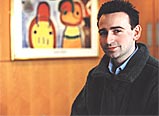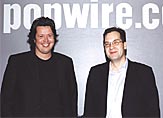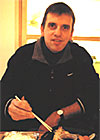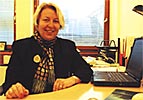Europe and Japan: Wireless Wonders
Back to Contents of Issue: February 2001
|
|
|||||||||||||
|
by Jacob Adelman, reporting from Hamburg, Germany |
|||||||||||||
"The first thing we did was we got on a plane, went to Japan, and saw all these Japanese companies, and we've focused on Japan since then," says Charig, now chairman of the company. Charig's own experience with the Japanese market extended back long before that fateful 1992 flight. He'd spent years as a stock trader, during which time his main clients were large Japanese securities firms, and had later founded a company that helped Japanese corporations enter the European market. "Then I came across this technology that was being developed by one of the world's leading videogame engineers [Chris Hinsley], who is now the R&D director here," Charig says. "I could see where it could be applied." The technology's logical application, Charig thought, was to Japan's consumer electronics industry. Hinsley was developing a platform on which he could develop a game once, and then have it run on any manufacturer's console without having to rewrite its code. Charig believed that this concept would be even more valuable to the "smart" appliances that were just starting to come out of Japan. The development of these appliances has borne out Charig's hunch. As more high-tech gadgets enter the market -- and more existing products incorporate digital technology -- the Reading-based firm's software, which has grown into a Java-based development platform called intent, has found an extraordinary number of applications. "We have developed a consumer media stack for all of the various connected appliances that are being developed now in areas such as digital television, smart phones, Web tablets, and digital cameras," Charig says. When manufacturers base their appliances on the intent platform, content and interface can migrate seamlessly from one device to the next, maintaining the same branded look and feel. And Japan's brands' reputations, Charig says, are their greatest assets.
But while Japan has been setting the world standard in the production of branded, high-quality consumer electronics, it's been less than exceptional at developing the sophisticated software and IT solutions that make these appliances run. This makes it a receptive market for Tao's technology. Indeed, Tao's present and past collaborative partners in Japan include JVC, Fujitsu, Justsystem, and Ascii, while it counts Sony among its investors. "Japan, for us, is at the heart of everything we do commercially," Charig says. Tao is not alone. Japan's electronics industry, traditionally oriented toward mass production, is increasingly looking abroad for its specialized IT solutions. And it's finding them among Europe's wealth of modest-sized enterprises.
European companies, in turn, see Japan's massive industry as the perfect antidote to the limits that their own relatively small domestic markets impose upon their growth. "Our economy is basically set up by medium-sized companies," says Wilhelm Berg, Germany's coordinator for the pan-European Gateway to Japan export promotion campaign. Because of their smaller size, European companies can afford to have a highly individualized, customer-focused orientation, while Japan's smaller number of large companies need to produce and sell lots more identical products to stay afloat. "In Japan, they streamline production. They go for high output and they don't care much about individual solutions, so there are niche areas that are neglected in Japan where the European industry fits perfectly. But a niche in Japan can be much bigger in size and more profitable than some of the original markets in Europe." Berg says the German translation-software company Trados, which entered the Japanese market in 1998 after participating in the Gateway campaign, is a prime example of a European company that filled a massive niche in Japan. The Stuttgart-based firm developed a database architecture that remembers how a translator renders specific terms and sentences, and then suggests these previous translations when the translator encounters the same phrases later in the text. The software also allows entire translations to be recycled for new renderings of similar texts, like the instructions that accompany different models, or an update, of a single product. The benefits of such software to Japan's export-intensive consumer electronics industry -- it has to prepare instruction booklets in countless languages -- is obvious. But the need for this kind of product was too specialized to register on Japan's corporate radar. "It would have been easy for a Japanese company to set up this line of business," Berg says, since the skills are there. "But, because companies in Japan are going for the mainstream, they didn't. A German company did. It's a limited market, but the entire Japanese market is so big that for a small or medium-sized company, it's a tremendous opportunity." The Japanese market is so big, in fact, that few small Japanese IT companies are establishing themselves in Europe, while many of their European counterparts are doing the reverse. "In terms of pure market size, the domestic market is so big that there is, in my opinion, no need to go abroad," he says. "A small Japanese company serving the domestic market is so busy that it doesn't have the manpower to develop markets abroad." Large Japanese electronics companies, on the other hand, have always had a presence in Europe, where they enjoy the same sort of brand recognition that they do all over the world. Fujitsu, for one, beefed up its European presence in late 1999 through a joint venture with Germany's Siemens AG. In line with the mass-production model set out by Berg, Fujitsu has come to Europe to make and sell more computers. "PCs and operating system products always require a scalable economy and exposure to a wider marketplace, rather than to a small number of high-end customers," says Tetsuo Urano, executive vice chairman of Fujitsu Siemens Computers, now Europe's principle channel for Fujitsu PC products. Fujitsu and Siemens, individually, have been particularly active in establishing respective partnerships with European and Japanese companies. Siemens and Toshiba announced in November that they would together develop third-generation mobile handsets for both Asian and European markets. Fujitsu, meanwhile, has been cooperating with Deutsche Telekom's T-Online International ISP through its group member Nifty in the context of a global Internet alliance. BUT THE NEW JAPANESE arrival that's getting the most press these days is NTT DoCoMo. DoCoMo bought a stake last year in the Netherlands' KPN Mobile -- from which it's expected to launch its European wireless Internet service -- and has established a European entity, DoCoMo Europe S.A., in Paris.
"Although we have this high penetration of using mobile phones for voice calls, not too many people use them for anything else," says Johan Montelius, a senior analyst at Jupiter Research in Stockholm. This is despite vigilant attempts by Europe's carriers and engineers to promote the service and develop world-class cellular technologies. Many look to Japan's now legendary wireless market in general, and DoCoMo in particular, and ask themselves, "What did we do wrong?" Analysts propose a number of theories.
Moss says that bad PR has also dampened European enthusiasm for using WAP -- the wireless access protocol that Europe uses as its mobile Internet standard. "The other thing about WAP handsets is that they've been marketed rather badly," he says. Advertisements neglected to feature the handsets' relatively unexciting screens, misleading consumers into overestimating the sophistication of WAP transmissions. "A number of people who have bought the handsets have actually taken them back because they'd been misinformed by the advertising and wanted something from wireless that's the equivalent of a fixed line. And of course it's nowhere near that." In fact, the weakness of WAP, compared to the compact HTML (C-HTML) protocol that DoCoMo's i-mode network uses, is also often cited as a reason why Japan's wireless Internet penetration is so much higher than Europe's. C-HTML supports color images and more sophisticated graphics than WAP, so it's more appealing to users. And since C-HTML is just a subset of HTML, experienced Web developers have a much easier time designing cellular content for it. "Maybe that's why WAP never took off in Europe: It's just too difficult," says Peter Bellew, whose Irish firm wapprofit.com recently developed a PC-based English-language i-mode C-HTML editor. But European analysts and developers generally dismiss this argument. "There's been a lot of bad press about WAP, and WAP is often talked about as a technology that's unripe, which it's not," says Strategis's Moss. Rather, he says, the strengths of WAP have yet to be fully exploited. The advantage of WAP is that it's based on WML -- wireless markup language -- which is itself a subset of XML, or extensible markup language. XML, he says, is far more versatile than HTML, while WML is a language that was specifically designed for the transfer of textual information across separate wireless devices, which makes it the most suitable option for mobile handsets. "We won't see WAP disappear or be taken over in Europe by some compact HTML, but instead we'll see how WML evolves and brings more functionality," says Jupiter's Montelius. The technical element in which Japan has had an advantage, Montelius says, is in its packet-data-based networks, over which providers can charge their customers based on the amount of data they download, as opposed to the pan-European GSM network, where customers pay by the minute. "It turned out that it's not very good to run WAP-like data services over the circuit-switched GSM network," Montelius says. "It's not so much the speed of the network. The problem is that when you're being charged by the minute, you're being charged quite a lot." However, this problem is bound to disappear as Europe's GSM network is upgraded to the packet-based GPRS over the course of this year.
"First of all, NTT DoCoMo was already the largest mobile operator, so they started with a large stock to work from," Montelius says. This not only gave them an established customer base, it also put them in a position to dictate standards and make sure that their suppliers conformed to them. "No single operator in Europe could do that: they're not strong enough, they're not big enough. "Then, I think, what they did right was in their business model, how they didn't build up their i-mode portal and they didn't decide what should be in there," instead inviting independent providers to develop content and charging them a small commission. "That was important," Montelius continues, "because for smaller content providers, it's very hard for them to open up a billing relationship with customers, especially if it's just a dollar or two a month." European operators, meanwhile, have been far more reluctant to share revenue with content providers, which has yielded much less content and, consequently, much less interest in the wireless Net. But the stunted growth of Europe's wireless Internet notwithstanding, the region has been a hotbed of development of cellular technologies. Strategis's Moss says that European manufacturers and carriers have been reacting to market potential, rather than the market itself, and are developing technology ahead of the wireless boom they're sure will hit. "There is such an enormous market potential because we have so many mobile subscribers in Europe," he says. "Europe is responsible for the bulk of all GSM subscribers, and GSM is the principle technology in the world. And that makes Europe a very lucrative marketplace, especially with regards to 3G." Like other IT sectors in Japan that are benefiting from Europe's specialized touch, much of the wireless technology Europeans are developing is finding application in Japan. But within wireless, Japan is at the top of the game -- it's the obvious destination for any European cellular developer that wants to grow beyond its market. "We've got a relatively small market here," says David Frodsham, CEO of Argogroup, based in Surrey, England. In December, Argogroup entered the Japanese market with AnyMobile, a wireless software architecture that accepts C-HTML pages and translates them on the fly into HDML for EZWeb handsets and MML for J-Sky ones. "We could not possibly live off the UK market; we have to go where the market is." By working in a market more developed than their own, European wireless companies in Japan also get the chance to test and develop their technologies, while establishing their own brands. "Japan is a crucially dynamic market. It's also the market that's going to be launching wideband CDMA services first. So you're going to have people who are keen to develop services and be big players within the European market seeing the Japanese market as the perfect stage upon which to make a name for themselves," says Strategis's Moss. "If you can prove that you can be a success in Japan, then once W-CDMA is active in Europe, people are going to want companies working with them who have proven experience in that arena. That's making Japan a very attractive market for the development of wireless."
"For us not to be there would be shooting ourselves in the foot," he says. "We have a state-of-the-art product for the mobile internet, and if we're not in the most advanced market at the right time, there's no way we can win this race that will start very soon."
Popwire.com is not the only Swedish company in whose Japanese-market-entry strategy Ericsson plays a role. All the Swedish companies doing business in Japan consulted for this story say they have some kind of relationship with Ericsson, whether as an investee, a partner, or the current home of its former staff members. Sonny Soderberg, the manager of the Swedish Trade Council's office in Tokyo, says Ericsson is the driving force behind Sweden's wireless proficiency -- and the reason why so many Swedish cellular companies are now entering the Japanese market. "I think Sweden is really on the forefront in IT in Japan. We hear it said, and the Swedish Trade Council has seen recently a number of Swedish companies popping up here," Soderberg says. "I think Ericsson is the engine in the whole thing here, if we're looking at the cellular side." Ericsson, she says, has invigorated Sweden's cellular industry, not only through its own development, but also through that of companies formed by its former employees, its spin-offs, and the companies it supports, many of whom are now entering Japan. Of course, Ericsson also has a strong independent presence in Japan. It provides J-Phone's J-Sky network with its system-integration infrastructure, and the i-mode network with other hardware. It will also supply the support systems for J-Phone's W-CDMA network in the Tokyo, Osaka, and Nagoya regions, over which 3G services will eventually be offered, and last year conducted field trials of Internet voice transmissions over W-CDMA with Japan Telecom. But aside from its technology, says Stefan Karlsson, Ericsson's vice president for marketing and sales of wideband and packet-data systems, the company offers itself to Japanese operators as a worldwide channel through which technology and strategy can travel. "What we do is help operators in Japan by sharing best practices with other operators in the world," he says. "I would most certainly say that in Japan quite a few things are the best of their class in the world," like handset design and mobile Internet image formats. "But there are other fields where there are empty holes in the picture in Japan, where other parts of the world might be best in the class," like e-commerce. Ericsson's worldwide presence allows it to take Japan's best practices and share them with the rest of the world, while reinforcing Japan's weaknesses with expertise developed elsewhere. This strong presence in Japan makes valuable the connections Swedish IT companies have with it when they open operations there. Firms are eager to leverage their relationships with Ericsson into ones with Japanese corporations. Take Stockholm's Adcore, a Web consultancy with a pan-European presence that entered Japan last summer. Having had no previous experience working with Japanese companies, Adcore plans to concentrate its initial Japanese efforts on serving European companies doing business there [in Japan] with whom it already has a relationship -- like Ericsson. "Our strategy is to start to approach the Scandinavian and European companies in Japan -- Ericsson for instance -- and start to work with them," says Johan Ek, Adcore's senior vice president for corporate finance. Adcore, as a major Web solutions provider in Europe, where the fixed-line Internet is more advanced than in Japan, can offer Japanese companies a level of expertise that it wouldn't be able to find among domestic firms, Ek says. But he recognizes that Japanese firms will be hesitant in the beginning to work with his company. "It can be quite tricky for us as a newly established company to approach Japanese companies, but when we have established our own network in Tokyo, for instance if we work with Ericsson, we can have a reference to it when we approach the Japanese companies."
"We had Ericcson Japan as one of our major clients during the last year, so we decided that we really need to be present in Japan to make life a little bit easier to work there, and not fly people over from Stockholm all the time," says Tommy Ljunggren, a Northstream senior partner. Northstream's experience in Japan demonstrates the value of being in Ericsson's orbit. Through an Ericsson Japan connection, Northstream has been working with DoCoMo, arguably the most coveted dream of all Sweden's wireless elite. When popwire.com COO Anders Norstrom is asked if the company's Japanese operation has been talking to anyone in Japan about the services it can provide, he responds: "We've been talking to 'the one' in Japan." There's little question about which "one" he means. "I-mode has created a lot of interest because it has people using the wireless internet so widely, sending messages and using it as a tool," says Anita Jonsson, IT and telecom director at the Swedish Trade Council in Stockholm. "They are very quick adapters, and that also creates a lot of interest among Swedish companies." ASIDE FROM ITS CONNECTION to Ericsson and the strong reputation it has earned in Europe by filling its staff rolls with tenured experts from high-profile telecom firms, Northstream's Japanese operation enjoys another advantage: the office space it rents from the Swedish Trade Council Business Center in Tokyo. In the council's Tokyo Business Support Office, the facility's staff take care of day-to-day tasks for the Swedish companies there, freeing them up to concentrate on their growing Japanese operations.
The Trade Partners UK export-promotion campaign operates a similar incubator. Its British Industry Center in Yokohama hosts a number of IT firms from the United Kingdom. Ireland's Enterprise Development Agency, whose IT-oriented activities have included seminars for Irish wireless professionals on mobile technology in Japan, is in the process of establishing its own incubation center. JETRO itself provides free office space and services for up to four months to foreign IT companies in its Business Support Centers. Hybris, a Munich-based e-commerce software developer, is one of two European IT firms nurturing its Japanese operations from a JETRO center. "Obviously, if you have an office where you find the basic settings, like telephone, fax, copy machine, et cetera, as well as a conference room where you can meet customers, it is much easier to concentrate on your business from the very start: exactly what you want to do," writes Thomas Latka, who heads hybris's Japan operation, in an email from Tokyo. While a local presence is useful to any type of company, Wilhelm Berg of Gateway to Japan says its especially vital to IT companies, whose software products can't simply be exported, but require localization and customization processes that are best done in Japan. "You can't do it yourself over here [in Europe] because you don't find that many people who know Japanese, who know the operating system," Berg says. "So if they want to enter the market, they have to be present in Japan, they have to tie up with a Japanese company or open up their own company in Japan." Berg says the IT companies he accompanied on a recent Gateway session in Japan told him "that they definitely have to be present in Japan with their own offices, because otherwise there's no chance for them to do business."
"Some people are shocked by the figures, because Japan is really expensive," Berg says. "It makes some people think twice about it." Faced with the expense of expanding abroad, European companies are more likely to grow regionally. He says this is especially true of IT solutions providers, which, in Europe, have traditionally had enough regional success not to have to worry about foreign markets; and when they do expand abroad, it's usually first to other European countries with similar languages and cultures. This also explains the relative lack of southern European IT firms in Japan, despite the substantial amount of high-tech development going on in countries like Spain and Italy. But Berg says southern Europe's weakness in foreign languages, combined with the largeness of the region, which includes Spain, Italy, and southern France, has limited growth beyond the Continent. Still, Berg says that cost, language, and low motivation to grow beyond ones already lucrative regions are not the only obstacles between European companies and the Japanese market. Europe and Japan also share a mutual unfamiliarity with each other's language and culture that makes the United States a more obvious and popular direction in which to expand overseas. On top of that are factors specific to Japan's business demands that make it hard for any company to enter. Europe's recognition of this is reflected in the fact that Gateway to Japan is its largest export-promotion campaign directed at a single country. "Japan needs more of a strategic approach, it needs more adjustment of the product," Berg says. "Whatever marketing step you're doing, whatever product-related adjustments you have to do, it always takes a bit more in Japan than in other countries. One reason is that the quality awareness is the highest in Japan. And the other one is: as we call Japan the Far East, the Japanese would definitely call us the Far West. If you see the school map in Japan, Europe is at the absolute outer section, whereas America is the direct neighbor to Japan -- there's only water in between. The United States is the prime investment target market for Japanese businessmen and finance institutions, and you have a lot of Japanese going for schooling to America, because they realize that English is the must in worldwide business. So this is definitely a setback for the Europeans." Another problem Europeans have to tackle are the long periods of relationship-building that Japanese companies require before they'll commit to any sort of long-term partnership. "They don't buy right from the beginning; they start doing it in bits and pieces and increase and increase until they reach the volume they targeted," he says. "They want to make sure that they can rely upon the partner; that the deliveries are on time; that the quality is what the Japanese market needs and the price and other aspects of the business fit them." European IT executives doing business in Japan tend to agree. "If you're going to work with Japanese companies, you need to build up relationships," says Mark Collins, commercial director of TTP Communications, which develops GSM handset software for Matsushita Electric Industrial Co. and Hitachi, mostly for phones that the companies export to other Asian countries using the GSM standard. "If you think you can jump on a plane and just sell something to a Japanese company you've never met before, you can forget about it." At the same time, Japanese companies in Europe have to adjust themselves to a market that prizes price and performance above established relationships. "Japan has markets for each vendor, so to speak: there are established relationships. Hitachi with this set of people, Fujitsu with this set of companies, NEC ... and so on. There are certain markets that you have as if they were your captive," says Urano. "In Europe, I think customers are more competition oriented. They set up two or three vendors of PCs, so they can always get some assurance of supply, competing terms and conditions, and better service from each of those selected vendors. So I think European customers are tougher." However, some Europeans doing business in Japan say relationship-building is one area where they have a strong advantage over their American competitors. "Contracts are not as fundamental in Japan and Britain and Europe, I think, as they are in America," says Charig of Tao Group. "In Europe and Japan, the contract is something you quickly draw up and then forget about because the relationships are everything." "Japanese and north Europeans just get along well" says Lars Christensson, who, as a wireless expert for Stockholm venture capital firm Startupfactory, has been monitoring the Japanese market. "The business cultures are different, but not as different as the US culture is from Japan's." European executives are prone to reconcile disputes with mutually agreeable solutions, he says, while US executives tend to be more aggressive. "American companies are very strong in positioning themselves so that they prevail. They say, 'This is the American way, take it or leave it,'" says Urano. "So making an alliance with them is somewhat difficult for Europeans and Japanese. Sometimes it works, but generally speaking, pushing and trying to prevail meets with resistance from Europeans and Japanese." Urano says that products conceived in a mutually conciliatory Japanese-European partnership are bound to be better suited to a non-US customer base. This, he says, informs one of his company's reasons for being: to offer European consumers PC products with their needs in mind. "We understood from our experience with European customers that they want and deserve some European difference from what is offered through America's push program, so to speak," he says. But on a more tangible level, Urano says that the background European and Japanese companies share in cellular technologies makes cooperation in that field even more valuable. He says the wireless EMTS networks that Europe will soon establish, for example, can be advanced by Japan's semiconductor industries' proven ability to manufacture chip sets designed for the technology. Japan's ability to develop and promote the wireless Internet even has many European IT companies going against the conventional wisdom that the first stop for overseas expansion is the United States. "Conventional wisdom is wrong," says Ljunggren of Northstream, which has an office in Japan, but not the United States. "Because Japan is really ahead. The US is behind in mobile, and there is really not as much reason to open up there as in Japan. We want to be where it all happens."
|
|||||||||||||
Note: The function "email this page" is currently not supported for this page.











